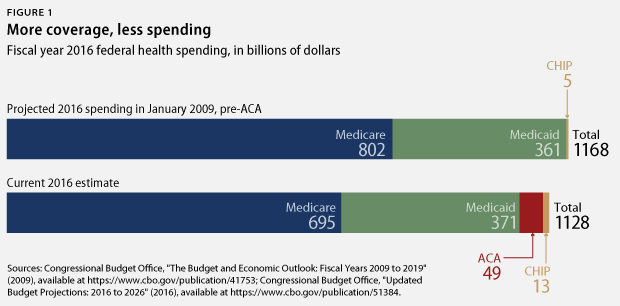On March 24, the Congressional Budget Office, or CBO, published data that might have surprised even the staunchest advocates for health care reform: New estimates show that total federal spending in fiscal year 2016 for major health care programs will be lower than was projected back in January 2009, shortly before President Barack Obama took office. Why is this shocking? The January 2009 projections for FY 2016 spending did not include the Affordable Care Act, or ACA, which was not signed into law until March 2010. This means that federal health programs are covering more people while spending less money.

Expanding coverage and saving money
The U.S. Department of Health and Human Services, or HHS, estimates that 20 million more Americans currently have health insurance because of the ACA. Yet federal health care programs are spending less than projected before this coverage expansion—even as the share of Americans without health insurance declined from 16 percent in 2010 to 9.1 percent in 2015. To be sure, the ACA coverage expansion did indeed add new costs to federal health programs. The CBO estimates that the federal government will spend $49 billion in FY 2016 to help Americans purchase health insurance on the exchanges, and the ACA also expanded Medicaid eligibility and increased federal support for the Children’s Health Insurance Program, or CHIP.
However, while the ACA coverage expansion adds new costs, total spending for federal health programs is still less than what the CBO projected in January 2009 because of huge savings from Medicare. The CBO’s projections for FY 2016 Medicare spending have fallen $107 billion since January 2009. In those January 2009 projections, the CBO estimated that Medicare, Medicaid, and CHIP would cost $1.168 trillion in FY 2016—a projection that did not include the future expansion of coverage under the ACA. Yet the CBO now estimates that Medicare, Medicaid, CHIP, and the ACA will cost $1.128 trillion in FY 2016.
Medicare reforms in the ACA are unambiguously responsible for a portion of the Medicare savings relative to CBO’s January 2009 projections. These policies include penalizing hospitals for readmissions; reforming Medicare payments to reward health care providers for quality instead of quantity; and establishing the Center for Medicare and Medicaid Innovation to test more efficient systems for health care payment and delivery. Rather than reducing Medicare spending by cutting benefits, these reforms save money by making the health care system more efficient. The CBO estimates that repealing the ACA’s Medicare reforms would increase deficits $802 billion over 10 years, which further illustrates their effectiveness.
In addition to savings that the CBO attributes directly to the ACA’s Medicare reforms, another reason for the decline in federal health spending projections is the dramatic reduction in cost growth throughout the health care sector. HHS reports that spending per beneficiary in both Medicare and private insurance grew slower than the overall economy in 2014—the last year for which data are available—and spending per beneficiary actually declined for Medicaid. While there are many possible causes for this broader slowdown in health care cost growth—such as the economy, increased use of generic drugs, and a shift in care from inpatient to outpatient sites—the cost controls in the ACA appear to be one reason for this development as well.
Even if total federal health spending were to exceed the pre-ACA projections in future years, the ACA would still be a fiscally responsible law. The Medicare reforms in the ACA were never meant to fully offset the cost of the coverage expansion. The CBO originally estimated that the ACA would reduce deficits—and continues to report that ACA repeal would increase deficits—because the law also includes policies to raise revenue.
Although the CBO’s projections assume that health care costs will return to more normal growth rates in future years, the CBO’s long-term projections for Medicare spending have nonetheless fallen dramatically. Projected growth in Medicare spending still presents a long-term challenge for the federal budget, but enormous progress has been made on this front during the Obama administration.
Conclusion
The CBO typically releases detailed updates for federal health care programs every March, so this will likely be the final update published before President Obama leaves office next year. This new data shows that the ACA has dramatically exceeded expectations: 20 million more Americans have health insurance because of the law, and total spending for federal health care programs is below the levels that the CBO projected for FY 2016 shortly before President Obama’s 2009 inauguration. Covering more people for less money is, as Vice President Joe Biden said when the ACA was signed into law, “a big … deal.”
Harry Stein is the Director of Fiscal Policy at the Center for American Progress.